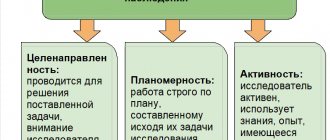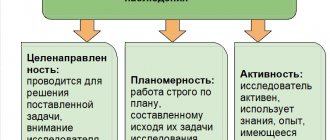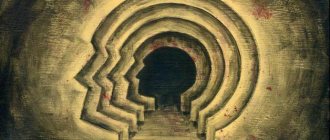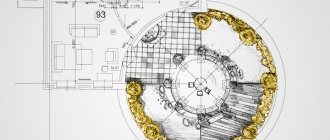Object and subject of observation
The object of observation is individuals in various situations of social interaction or large and small groups, communities.
The subject of observation is the verbal and non-verbal acts of behavior of an individual, group or several groups in a certain social environment and situation:
- speech acts, their content, sequence, direction, frequency, duration, intensity, expressiveness, features of semantics, vocabulary, grammar, phonetics, synchronization;
- expressive movements, expression of face, eyes, body, sounds;
- movement, movements and stationary states of people, the distance between them, speed and direction of movement, contact;
- physical impact: touching, pushing, hitting, supporting, joint efforts, transferring, taking away, delaying;
- a combination of the listed characteristics.
Objective observation is aimed not at external actions in themselves, but at their psychological content. Here, the external side of activity and behavior is only the raw material of observation, which must receive its psychological interpretation and be comprehended within the framework of a certain theory.
Testing
Testing
A method of obtaining psychological facts using a list of standardized questions or tasks (test).
Currently, tests have been created designed to study almost any mental processes, states and personality traits. The widespread use of testing in psychology is due to the fact that with the help of tests it has become possible to compare and determine the mental development of individual functions and qualities of people relative to normal and pathological conditions. In addition, testing allows you to collect a large amount of material in a short period of time and process it quite easily.
Classifications of types of observation
There are several classifications of types of observation method depending on:
- degrees of formalization - controlled and uncontrolled;
- the degree of participation of the observer in the situation under study - included and not included (with included observation, objectivity suffers);
- conditions of the organization - open and hidden (with open observation, people behave unnaturally);
- venues - field and laboratory;
- regularity of implementation - systematic and random;
- ascertaining and evaluative;
- continuous and selective (selective observation records the behavior of one person);
- observation and introspection.
Self-observation, in turn, can be direct (self-report) and indirect (analysis of diaries, letters, autobiographies). The advantage of self-observation is the ability to obtain information that is not available to other research methods.
Psychological observation: definition of the concept
Observation in psychology is one of the main methods of knowing the characteristics of an object empirically. The method requires a mandatory transition from describing facts to explaining their essence, forming a psychological characteristic of what is being observed.
The results of applying the scientific method can be influenced by the following factors:
- level of knowledge in the area under study;
- professional experience, qualifications of the observer;
- personal experience, emotional and mental stereotypes, value orientations of the psychologist.
Observation presupposes the non-interference of the subject in the process or situation under study.
The method makes it possible to get a complete picture of what is happening and reflect it through records and tables. A special feature of the procedure is the complexity, and often the impossibility, of accurately repeating the observation situation.
Requirements for surveillance and its effectiveness
In order for surveillance to be effective, it must meet a number of requirements:
- it must be selective, i.e. proceed from a clearly defined goal, highlight a certain aspect of the object being studied;
- it must be planned and systematic, i.e. be built on the basis of a specific plan and carried out over a certain period of time;
- it is important to record the observed phenomenon in as much detail as possible, i.e. completeness of observation is necessary;
- It is imperative to define observation situations, identify units and signs of observation, as well as methods for recording them.
To take into account all these requirements as much as possible, as a rule, an observation program up, which in a formalized form includes the following points: goals and objectives of observation, object of observation, subject, method and type of observation, observed situations, units of observation, observation tools.
The effectiveness of observation depends significantly on the significance of a given situation for the personality of the observer. Increasing the effectiveness of observation is possible if there is a rejection of premature assessments and generalizations, multiple observations, reinforcement by other methods, and the presence of special equipment (for example, a reverse vision mirror).
Typical Observer Errors:
- The effect of leniency - the observer does not dare to give a negative rating;
- The central tendency effect is the tendency to give average grades;
- Logical errors (one who is articulate is judged to be smart, etc.);
- Haloeffect - by highlighting a bright feature, the observer changes the assessments of all other qualities.
Code of Ethics
For the proper use and characterization of the observation method, one must follow the basic rules of psychology as established by the Code of Ethics of the American Psychological Association. The researcher must adhere to precautionary measures.
If the trial is carried out in a public place, it is not necessary to obtain the consent of the participants. And for individual research, you need to obtain the subject's permission . Psychologists must behave carefully and try not to harm others. If this cannot be avoided, it is recommended to reduce the damage.
Intrusion into the privacy of participants should also be kept to a minimum. But when observing the behavior of family members, you need to obtain their consent and explain the purpose of the task. If a person engages in self-observation, then he can study any area of his life. All data about the subjects remains confidential, psychologists have no right to disclose them. Only the results obtained can be published without indicating names, addresses and other personal information.
Observation stages:
- object selection;
- data registration;
- creating a plan;
- selection of information processing method;
- carrying out the procedure itself;
- interpretation of data.
At the first stage, the psychologist selects the object and subject, the time and place of observation. He then selects the most appropriate research method and records all the data. After planning and choosing processing methods, he proceeds directly to the observation itself. The results obtained are interpreted to produce a report.
Advantages and disadvantages of the observation method
The advantages of the observation method are:
- direct perception and recording of signs in real time;
- efficiency of obtaining information;
- objectivity and specificity of data;
- more accurate measurement of the intensity of acts or modes of behavior;
- the ability to test indirect methods of obtaining information (questionnaires and questionnaires);
- removing the influence of attitudes on the stereotypicality of questionnaire answers and corresponding forms of psychological defense;
- the possibility of a holistic assessment of the social situation.
The disadvantages of the observation method include:
- limited observation capabilities (not all situations can be found in life and the appropriate conditions can be created);
- strong influence of the attitudes and mental states of the observer;
- perceptual readiness to confirm one’s hypothesis;
- the possibility of researcher fatigue due to monotony;
- the influence of the researcher and the persons observed by him on each other;
- difficulties of interpretation due to causal-attributive distortions;
- significant time investment;
- the behavior of those observed is not always or not always unambiguously related to the mental phenomena that are being studied;
- errors of personal and psychological origin: a) “halo effect”, based on the generalized impression of the observer, a tendency to assess the situation in “black and white”;
- b) the “condescension effect,” which consists of the tendency to give an overly positive assessment of what is happening under the influence of a truly positive, but private trait;
- c) “error of central tendency”, which consists in the desire to average estimates of observed processes, because extreme signs of behavior are less common;
- d) a logical error based on the falsity of a judgment about the close connection of any human qualities (“courtesy”^ “good nature”);
- e) “contrast error”, i.e. emphasizing features of the observed that are opposite to those of the observer;
- f) “first impression” stereotypes of a professional, ethnic, age level (for example, the observer’s stereotypes, previously formed in relation to teenagers in general, police officers in general, etc., affect the observed persons - representatives of the same categories).
Differences between observation and experiment:
- Control and management of the independent variable is higher in an experiment;
- In observation, control of side effects is very weak;
- Observational hypotheses are less rigorous and clear-cut;
- Observation has a less rigorous procedure and less precise measurement of psychological phenomena.
Survey
Survey
A method of obtaining answers to specific questions that are formulated by the researcher.
It includes: questionnaire, conversation, interview.
Questioning is a method of psychological research using questionnaires. Using questionnaires, biographical data, values, attitudes, and personality traits are studied. A questionnaire is a list of questions that provides for the study of a certain psychological characteristic. Questionnaires can be open or closed.
Conversation is a method of obtaining facts by communicating with the respondent. Unlike a questionnaire, the researcher has the opportunity to ask additional questions.
An interview , like a conversation, is a method of obtaining facts through verbal communication. The main difference is that the researcher only asks questions. He does not interfere with the answer, its content and form.
What is observation? Types of Observations
What is observation? This is a research method that is used in psychology for the organized and purposeful perception and study of an object. It is used where the intervention of an observer can disrupt the process of interaction between the individual and the environment. This method is especially needed when you need to get a complete picture of what is happening and understand people’s behavior.
What kind of observation is there? Observation is a specially organized and recorded perception of an object.
It can be indirect and direct, internal and external, uninvolved and included, indirect and direct, selective and continuous, laboratory and field. According to its systematicity, it is divided into: 1. Non-systematic observation is a method in which a generalized picture of the behavior of a group of people or an individual under certain conditions is created. At the same time, the goal is not to fix the cause-and-effect relationship and formulate strict descriptions of phenomena.
2. Systematic, which is carried out according to a strictly defined plan. The researcher records behavioral characteristics and environmental conditions.
Based on the objects recorded, it is divided into:
1. Selective observation is a method in which the observer records only some parameters of behavior.
2. Continuous, in which the researcher records all behavioral features without exception.
According to the form of observation there are:
1. Conscious observation is a way in which the person being observed knows that he is being observed.
In this case, the observed person is usually aware of the goals of the study. But there are cases when the object is given false surveillance targets. This is done due to ethical concerns regarding the findings. Disadvantages of the conscious type of observation: the psychological influence of the observer on the object, which is why it is often necessary to make several observations of the object. Features: the observer can influence the behavior and actions of the object, which, if not thought through, can greatly change the results; those observed, in turn, may, due to some psychological reasons, pass off false actions as their usual ones, become embarrassed or give free rein to their emotions; such observation cannot be carried out in a person's daily life. 2. Internal unconscious observation is a method in which the observed people do not know anything about the fact that they are being observed. In this case, the researcher becomes part of the observation system. An example would be a situation where a psychologist infiltrates a group of hooligans and does not communicate his intentions. This form of observation is convenient for qualitative research of behavior in small groups. In this case, the presence of an observer becomes natural, which does not in any way affect the results of the study. Disadvantages of unconscious observation: difficulty in obtaining results; the researcher may become embroiled in a conflict of values. Features: the object under study knows nothing that it is being observed; the researcher receives a lot of information about what is being observed. 3. External unconscious observation is a method in which the object under study knows nothing about the observation, and the observer himself carries out his work without direct contact with the object. This method is convenient because the observer does not constrain the behavior of the observed and does not provoke their false actions.











